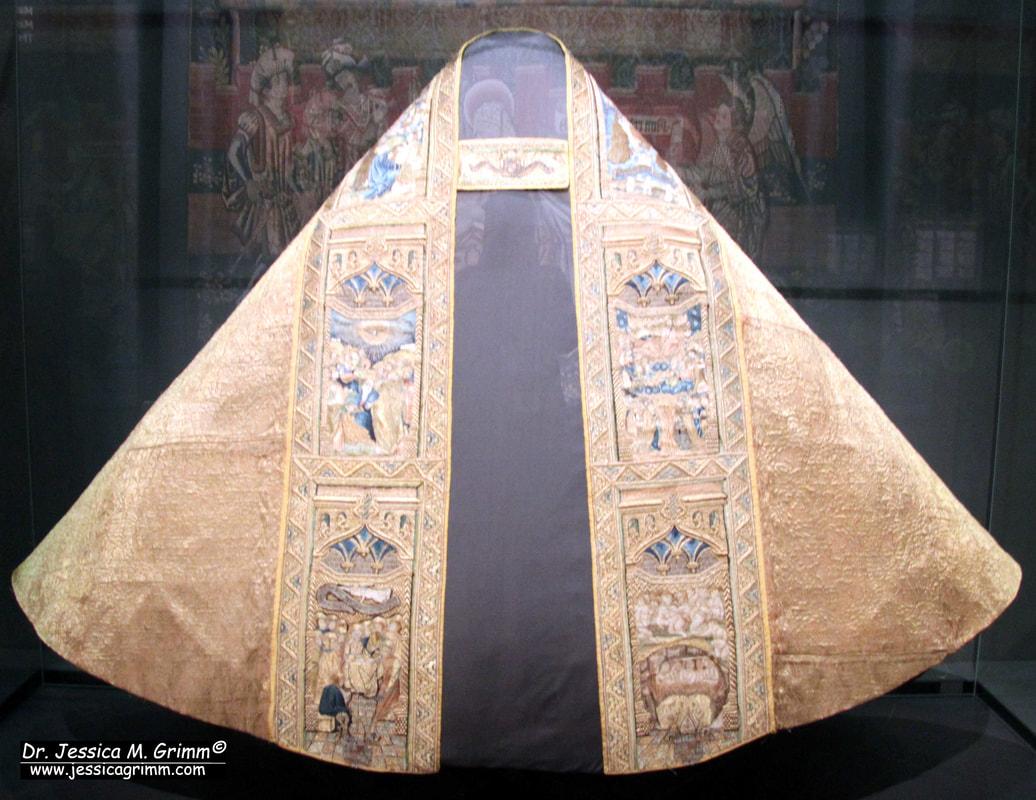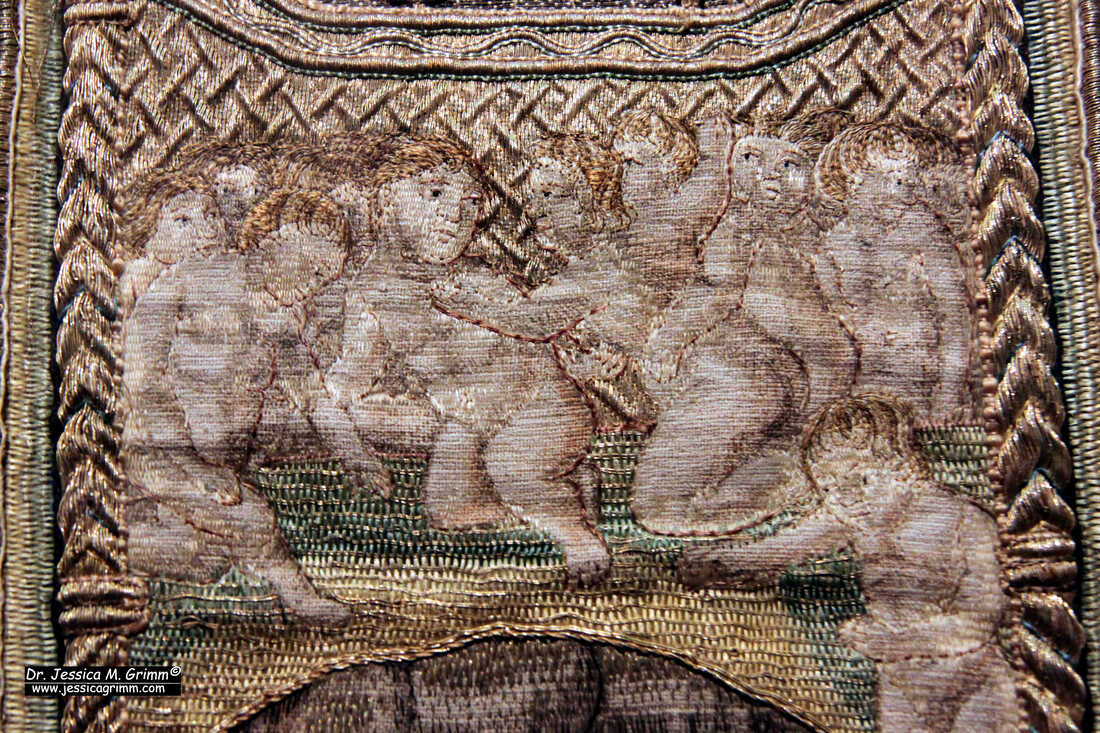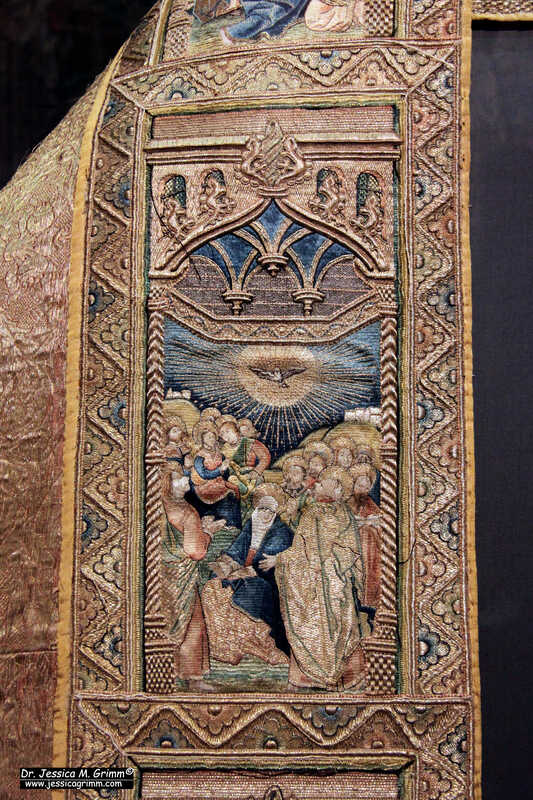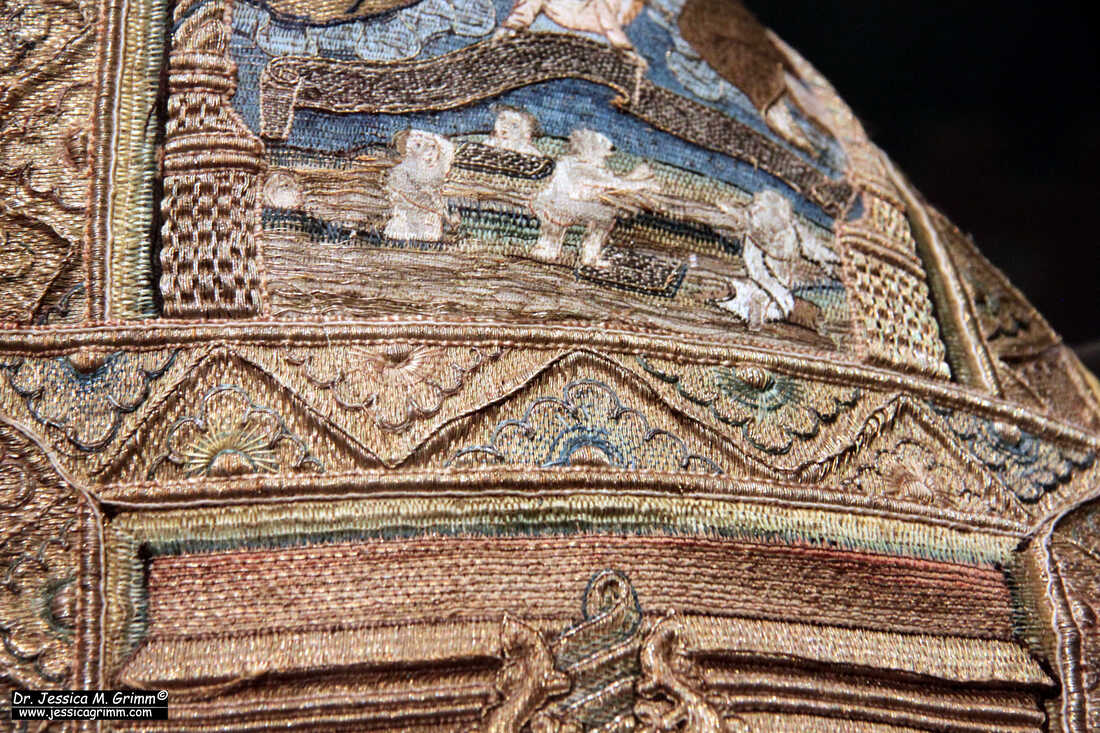|
Let's visit some gorgeous medieval goldwork embroidery from Lausanne Cathedral and currently kept in the Bernisches Historisches Museum in Switzerland. When medieval embroidery is your thing, this is a museum you definitely want to visit. Apart from the vestments from Lausanne Cathedral and many others, the museum also has the Grandson antependium from the 13th-century on permanent display. The set of golden vestments from Lausanne Cathedral consists of a cope (inv. 307, now on display), a chasuble (inv. 39) and two dalmatics (inv. 38 & 40). The embroidery was made between 1513 and 1517, probably in Brussels, Belgium. This expensive set of vestments made with Italian fabrics and very high-quality orphreys from the Low Countries was commissioned by Bishop Aymon de Montfalcon of Lausanne. Aymon clearly had deep coffers! As Mary is prominently displayed on many of the orphreys it becomes clear that the vestments were always intended for Lausanne Cathedral which is dedicated to Our Lady. The design drawings on the linen underneath the embroidery were made with black and red ink. The correct shading is also indicated with the ink. There is not a full-colour drawing beneath these embroideries. It is more or less sparse monochrome-shaded drawing. Enough so the embroiderer was aided during his work, but not so strong that it obscured the weave of the linen fabric and made the actual embroidery harder. It is important for the embroiderer to still be able to see the weave of the fabric as the silk shading is more akin to Chinese silk shading (very orderly and counted) than it is to the type of silk shading taught at the Royal School of Needlework (which is random). Although all orphreys on all four vestments clearly belong together and were thus made around the same time in the same place, they do differ slightly in the execution of the embroidery techniques. I am sure you can separate out several different embroiderers when you study these orphreys in depth. The designs also differ quite a bit stylistically and were clearly inspired by several contemporary painters such as Gerard David, Bernard van Orley and Cornelis Engebrechtsz. Simple 'one saint' orphreys from the Low Countries often consist of two or more pieces sewn together: a separate saint appliqued onto an embroidered background (of which some very dimensional elements might also be slips). The more complex orphreys of the golden vestments are mostly worked as one piece with only some figures being worked as slips. This is probably easier (and thus quicker) when you have many partly overlapping figures in a single scene. The backs of the orphreys have been stiffened by gluing used paper onto them (letters, invoices, etc.). Interestingly, true or nue is absent from these orphreys. Instead, most figures are stitched in a form of silk shading. The main figures in the foreground may have parts of their clothing stitched with goldthread. However, the horizontally laid goldthreads are couched in a bricking pattern using gold-coloured silks. The folds are accentuated with some simple line stitches in coloured silks. I have coined the term 'pseudo or nue' for this specific embroidery technique. It is often seen on orphreys from Germany, but rare on orphreys from the Low Countries. True or nue can create fantastic shading and suggest three-dimensionality. Pseudo or nue cannot achieve this. The floral frames around the orphreys are also unique. So far, I have not come across a similar pattern with coloured flowers. This might have been a trademark of this specific embroidery workshop.
If you would like to learn more about the golden vestments from Lausanne Cathedral then please buy the museum publication "Himmel und Hölle in Gold und Seide" by Annemarie Stauffer. There is also a French version available. The book has detailed pictures and descriptions of the orphreys of all four vestments. The introductory chapter is also very well written. You can order the book (22 Swiss Francs) directly from the museum shop by sending them an email. Please remember: when you order from the museum directly you help them financially. Something museums can really use after the many closures during the pandemic!
4 Comments
Linda Hadden
24/10/2022 21:46:52
Hi Jessica, Absolutely fascinating and totally stunning. Going to order the book.
Reply
Your comment will be posted after it is approved.
Leave a Reply. |
Want to keep up with my embroidery adventures? Sign up for my weekly Newsletter to get notified of new blogs, courses and workshops!
Liked my blog? Please consider making a donation or becoming a Patron so that I can keep up the good work and my blog ad-free!
Categories
All
Archives
July 2024
|
Contact: info(at)jessicagrimm.com
Copyright Dr Jessica M. Grimm - Mandlweg 3, 82488 Ettal, Deutschland - +49(0)8822 2782219 (Monday, Tuesday, Friday & Saturday 9.00-17.00 CET)
Impressum - Legal Notice - Datenschutzerklärung - Privacy Policy - Webshop ABG - Widerrufsrecht - Disclaimer
Copyright Dr Jessica M. Grimm - Mandlweg 3, 82488 Ettal, Deutschland - +49(0)8822 2782219 (Monday, Tuesday, Friday & Saturday 9.00-17.00 CET)
Impressum - Legal Notice - Datenschutzerklärung - Privacy Policy - Webshop ABG - Widerrufsrecht - Disclaimer










 RSS Feed
RSS Feed